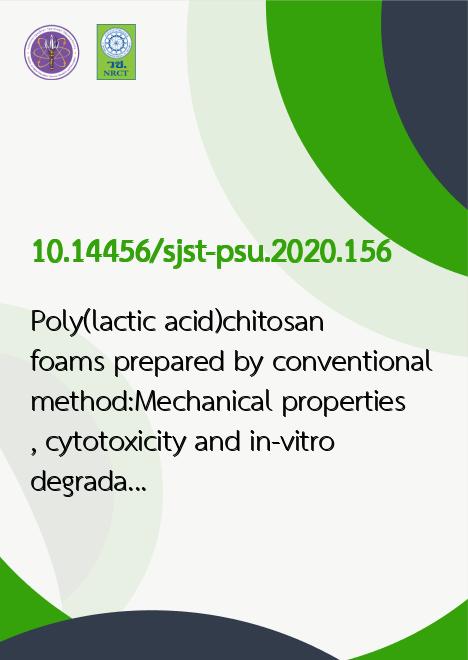
|
Poly(lactic acid)/chitosan foams prepared by conventional method:Mechanical properties, cytotoxicity and in-vitro degradation |
|---|---|
| รหัสดีโอไอ | |
| Creator | 1. Pasuta Sungsee 2. Varaporn Tanrattanakul |
| Title | Poly(lactic acid)/chitosan foams prepared by conventional method:Mechanical properties, cytotoxicity and in-vitro degradation |
| Publisher | Research and Development Office, Prince of Songkla University |
| Publication Year | 2563 |
| Journal Title | Songklanakarin Journal of Science and Technology |
| Journal Vol. | 42 |
| Journal No. | 6 |
| Page no. | 1207-1214 |
| Keyword | poly(lactic acid), chitosan, foam, tissue engineering scaffold, cytotoxicity |
| URL Website | https://rdo.psu.ac.th/sjstweb/index.php |
| ISSN | 0125-3395 |
| Abstract | The present study evaluated the feasibility of using a conventionally prepared poly(lactic acid) (PLA) foam. A PLAfoam was successfully prepared by compression molding. Azodicarbonamide was used as a chemical blowing agent. Chitosanwas added as a bioactive material and poly(ethylene glycol) (PEG) was added as a plasticizer for PLA. Chitosan promoted theplasticization effect of PEG. The combination of chitosan and PEG contributed the lowest Tg and Tcc of PLA. The plasticizedPLA showed greater impact strength than PLA. All foams showed closed-cell morphologies with relatively large pores. Chitosanand PEG reduced pore size and the reduction in pore size was greater when both additives were combined. Cytotoxicity wasdetermined from MG-63 cell proliferation on samples, and all foams showed non-cytotoxicity. The addition of chitosan and/orPEG decreased weight loss of PLA in in-vitro degradation tests. This work was preliminary work and more studies need to bedone. |
